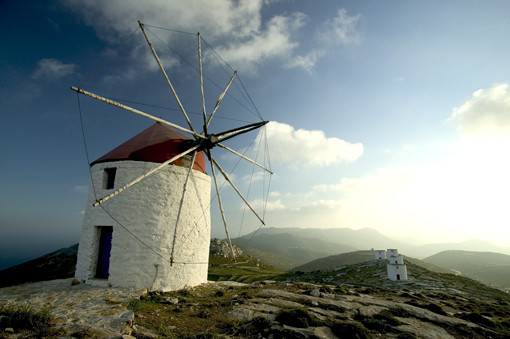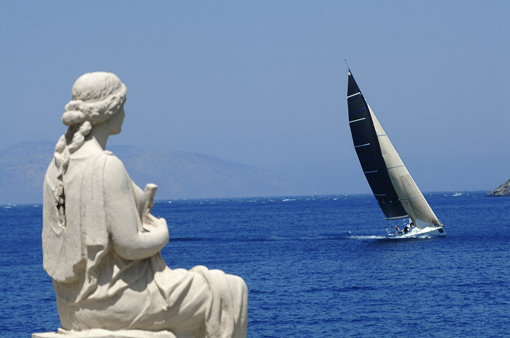 The island of the film “The Big Blue”
The island of the film “The Big Blue”Did you know that the 1988 movie “The Big Blue” with Jean Reno was shot on the island of Amorgòs, at the south eastern edge of the Cyclades? Parts of the island reach a considerable height above sea level, offering superb views out over the Archipelago, Amorgós is one of the most impressive Cycladic islands, boasting marvellous beaches with azure waters, gorgeous caves, ideal spots for diving, scenic bays and ancient footpaths leading through its steep rocky terrain… Inhabited since the Protocycladic Era, as indicated by archaeological finds brought to light in the area, Amorgós has a long cultural history and tradition. Step off the beaten track and visit an island that has preserved its traditional colour, where the locals welcome you with a smile on their face and make you feel at home!

Town of Amorgós (Hóra)
Built at the centre of the island and surrounded by rocky hills, the maze-like Hóra of Amorgós is considered to be one of the most picturesque in the Cyclades! Here you can admire a breathtaking setting with scenic squares, traditional Cycladic houses with Bougainville trees in their court yards and Lilliputian whitewashed alleys. In the morning you can wander around the narrow streets, visit the 13th century castle and the monasteries or relax at a local coffee shop; in the evening pick one of the cosy bars and tavernas scattered around Hóra’s streets and squares and enjoy local specialties accompanied by a shot of “psiméni” raki! Don’t be surprised if you come across a big group of people enjoying an impromptu feast - it is a very common event on the island- feel free to join in!
Katápola
Katàpola is the main harbour of the island as well as a haven for boats and small cruise ships. Set off on a boat trip from Katápola and explore the island’s sun kissed beaches!
Eyiáli
Eyiáli, the second harbour of Amorgós, is popular with young people as it is the site of the island’s camp site. Along its lively waterfront you will find plenty cafes and restaurants. Perched on a mountain behind Eyiáli there are three picturesque villages: Tholária, Lagkáda and Potamós; visit them at the end of the day – the sunset is beautiful.
Itineraries
There are seven footpaths on the island, mapped and sign-posted, along which you can discover the island’s diverse flora and fauna and its rich cultural treasures. They also all offer superb sea views!
1. Paliá Stráta (Hóra- Eyiáli bay): not an easy route to follow – it’s 11.5 km long! This 4-hour-hike starts from Hóra, continues past the Monastery of Chozoviotissa, goes half way across the island to Potamós and on to at Eyiáli Bay.
2. Fotodótis, connecting Hóra with Katápola, is an easy one hour’s walk along a cobblestone path with beautiful views to the sea…
3. Itonia (Leukes, Agioi Saranta, Kamari, Kastri, Vroutsi, Rahoula, Arkesini) is a 3-hour walk and it’s considered to be a difficult one (10 km). Discover sites of cultural interest, such as the ancient Acropolis, and let the history of the island unfold before your eyes!
4. The footpath of Melania (Eyiáli Bay, Lagkada, Stroumpos, Panagia Epanohorini, Tholaria) is a 4.5 km. route which goes past traditional settlements and ancient Cycladic ruins. The views of the bay are stunning. It is an easy two-hour walk.
5. The footpath of Pan (Lagkada, Agios Ioannis, Stavros, Krikelos) is a 6.5 km. two-hour route which goes past the Byzantine Monastery of Ioannis Theologos and Stavros Chapel and up to the highest point of the island, Mount Krikelos, 812 m. above sea level. Although it is considered to be a difficult path, the superb sea views make it well worthwhile.
6. Valsamitis is an easy one-hour trek. It goes past Ayios Georgios Valsamitis and ends at ancient Minoa, where you can admire preserved parts of the stadium, the gymnasium and the Temple of Dionysus.
Tip: Wear a pair of comfortable shoes and start early in the morning. Don’t forget to take plenty of water with you and a coat to protect you from the wind – at some points it can be unbearable!
Monastery of the Virgin Mary (Panayia) Hozoviótissa
The island’s top attraction is the 10th century cliffside monastery of Panayia Hozoviótissa, dedicated to the Presentation of the Virgin, a spiritual haven and one of the most important ecclesiastic monuments in Greece. Set high up on the steepest rock of Mt. Profitis Elias, 300m above the Aegean, the building resembles a “chest of drawers”, according to the French explorer Pitton de Tournefort. Visible only from the sea, the monastery is an example of human triumph over nature, a wonder that will leave you awestruck.
According to tradition, the monastery was founded by the Byzantine Emperor Alexios I Komnenos in 1088, during the period of Iconoclasm, when the icon of Panayia was sent by a woman from Hozovo from Palestine and miraculously made its way to Amorgós. According to another version, the Monastery was founded in the 9th century by monks from Palestine and was later renovated by the emperor Alexios I Komnenos.
The monastery has eight floors connected by narrow stone staircases carved into the rock. 350 steps lead you to the monastery, the interior of which is like a labyrinth. The cells of the monks are all carved into the rock to form a unique example of traditional architecture. Two icons of the Virgin Mary and other religious relics from the period of Alexios Komninos have been found at the monastery. Important heirlooms such as a manuscript, gospels, vestments and ecclesiastical utensils dating from the 10th to the 19th century are also on display.
There is a stunning view of the island’s wild beauty from the highest balcony of the Monastery. On the 21st of November there is a celebration of the Presentation of the Virgin Mary, the highlight of which is the procession of Her holy icon. After the procession there is a massive feast with plenty of food, wine and delicious traditional sweets!
Taste delicious local specialties:
• Xerotígana (fried pies filled with white beet and fennel)
• Ladotýri: sheep’s milk cheese stored in olive oil, hence the name “ladotyri” (lit. “oil cheese”). It has a strong, salty taste, a pleasant aroma and a hard, dry skin and is off-white and slightly yellowish in colour.
• Patatáto (goat cooked with potatoes)
• Psiméni raki (raki – the local spirit – scented and seasoned with herbs)
• Pastéli (sesame bar)
Beaches
The island boasts scenic bays, underwater caves ideal for diving and golden beaches, most of which are secluded (only a few are organised). You can reach them on foot or by boat.
• On Ayia Anna beach, where the film “Big Blue” was shot, you will find two amazing bays, one of which is home to the church of Ayia Anna. The beach is pebbly, with rocks and caves, crystalline waters and is ideal for snorkelling! Highlight: while you are swimming, enjoy the stunning view of the Monastery of the Virgin Mary Hozoviótissa carved into the steepest rock of Mt. Profitis Elias!
• Mouros Beach with its rocky landscape and secluded caves is superb! Take a moment to admire the breathtaking view from the top of the footpath that leads down to the beach!
• Ayios Pavlos is a small peninsula with pebbles. Take one of the boats departing from here to reach the small island of Nikouria, which boasts two amazing beaches.
• Eyiali beach is a long sandy beach with many beach bars and tavernas. At one end of the beach there is a path leading to the secluded beach of Levrossos.
• Kalotaritissa bay lies in the southernmost part of the island. It is a sandy, organised beach with beautiful blue water and a beach bar. Take a boat out to the stunning beach of Gramvoussa and bask on a white sandy beach with turquoise waters!
• Maltezi is only accessible by boat departing from Katápola. It is an organised sandy beach with blue-green waters and a beach bar.
• Mikri Vlyhada is a quiet secluded pebbly beach with crystal clear waters. In order to reach it you have to walk along a steep footpath (starting from Tholaria) but it is well worth the effort!
• Liveros bay is a small rocky beach with crystal clear waters; here lies the impressive wreck of the ship “The Olympia” which appears in the film “The Big Blue”.

Content by www.visitgreece.gr © GNTO